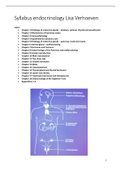Samenvatting
Summary endocrinology (NWI-BB048B)
- Instelling
- Radboud Universiteit Nijmegen (RU)
Gedetailleerde samenvatting (of zoals ze het bij dit vak noemen, syllabus) van de stof voor het vak endocrinology. Deze samenvatting is voorzien van zowel een literatuur lijst als de antwoorden/uitwerkingen van het project 'a hormone and its receptor' dat je tijdens dit vak gaat doen.
[Meer zien]




